
What is Tulsi Herbal Tea?

Tulsi herbal tea, also known as Holy Basil tea, is a popular beverage known for its numerous health benefits and rich flavor. This herbal tea has been used for centuries in Ayurvedic medicine to promote overall health and well-being. In this blog, we'll explore what makes Tulsi herbal tea special, how to make it, and why it should be a part of your daily routine.
What is Tulsi Herbal Tea?
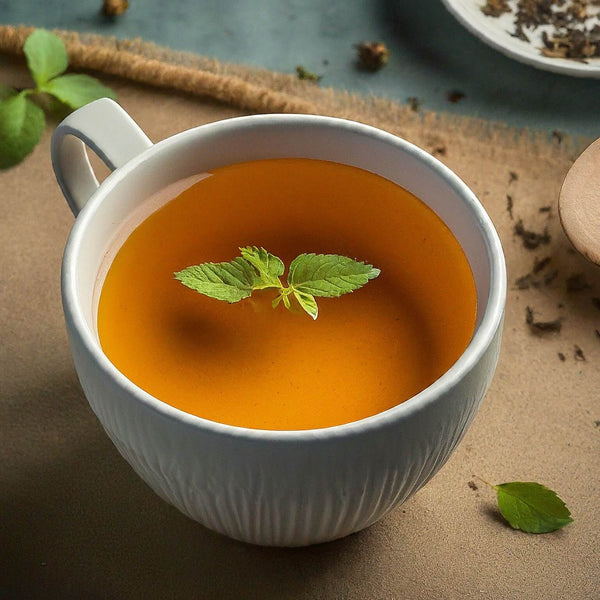
Tulsi Tea, is made from the leaves of the Tulsi plant, also known as Holy Basil. Tulsi is revered in India for its medicinal properties and is often referred to as the "Queen of Herbs." This tea is caffeine-free and packed with antioxidants, making it a perfect choice for those looking to improve their health naturally.
| Also read: History and Origin of Tulsi Herbal Tea |
Health Benefits of Tulsi Herbal Tea
Tulsi herbal tea, or Holy Basil tea, offers a wide range of health benefits:
1. Boosts Immunity:
Tulsi is known for its immune-boosting properties, helping the body fight off infections and diseases.
2. Reduces Stress:
The adaptogenic properties of Tulsi help reduce stress and promote mental clarity.
3. Supports Respiratory Health:
Tulsi tea is effective in relieving respiratory conditions like asthma, bronchitis, and allergies.
4. Detoxifies the Body:
Tulsi helps in detoxifying the body by flushing out toxins and promoting liver health.
5. Aids Digestion:
Tulsi tea can improve digestion and relieve symptoms of bloating and indigestion.
| For more detailed information, read: 7 Health Benefits of Tulsi Herbal Tea |
How to Make Tulsi Herbal Tea
Making Tulsi herbal tea is simple and can be done at home with a few ingredients:
Ingredients:
- Fresh or dried Tulsi (Holy Basil) leaves
- Water
- Honey or lemon (optional)
Instructions:
1. Boil Water
Bring a cup of water to a boil.
2. Add Tulsi Leaves
Add a handful of fresh Tulsi leaves or a teaspoon of dried Tulsi leaves to the boiling water.
3. Steep
Let the leaves steep for 5-10 minutes.
4. Strain and Serve
Strain the tea into a cup. Add honey or lemon for extra flavor if desired.
| Also Read: How to Make Tulsi Tea- Step by Step Recipe |
Tasting Notes
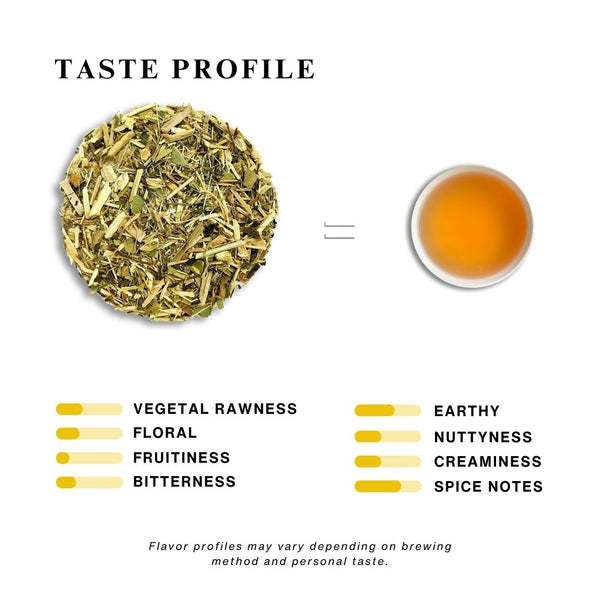
Tulsi Herbal Tea, known for its unique blend of flavors and aromatic properties, offers a complex and soothing tasting experience. Here's a detailed breakdown of its tasting notes:
-
Aroma: The first encounter with Tulsi Tea is its distinctive aroma, which is both refreshing and earthy. It has a sweet, herbaceous fragrance with hints of clove and mint that awaken the senses, preparing you for the first sip.
-
Initial Taste: Upon tasting, Tulsi Tea greets you with a mild, herbaceous flavor that is both comforting and invigorating. The initial taste is a gentle mix of sweet and savory notes, reminiscent of the freshness of green leaves with a subtle peppery spice.
-
Body: As the tea settles on the palate, its complexity unfolds. The body of the tea is rich and full, offering layers of flavors that include hints of mint, clove, and lemon. This complexity makes Tulsi Tea uniquely satisfying, with a balance between its cooling and warming properties.
-
Aftertaste: The aftertaste of Tulsi Tea is pleasantly lingering. It leaves a sweet and slightly spicy note on the palate, with a refreshing coolness reminiscent of mint. This aftertaste is soothing and leaves you feeling refreshed.
-
Mouthfeel: Tulsi Tea has a smooth and almost velvety mouthfeel. It's neither too astringent nor too heavy, making it an easy and pleasant drink that can be enjoyed throughout the day.
-
Overall Experience: Drinking Tulsi Tea is an uplifting experience. Its unique blend of flavors — sweet, spicy, and herbal — provides a calming effect on the mind and body. The tea's aroma, taste, and aftertaste work harmoniously to create a sense of well-being and tranquility.
From Leaf to Cup: The Journey of Tulsi Tea
The journey from leaf to cup with Tulsi Tea is like following a path paved with tradition, care, and the essence of nature. Let's explore this fascinating voyage, capturing the essence of what makes Tulsi Tea not just a beverage, but an experience to savor.
Harvesting the Tulsi Leaves
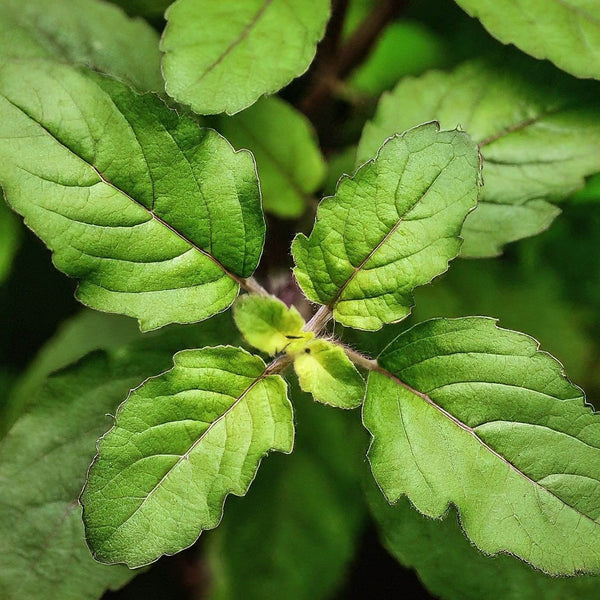
-
A Sacred Harvest: The journey begins in the lush gardens where Tulsi, also known as Holy Basil, thrives under the tender care of those who understand its value beyond just a plant. Harvesting Tulsi is more than an agricultural activity; it's a ritual performed with respect and mindfulness, often accompanied by prayers, acknowledging its sacred status in many cultures.
-
Picking with Precision: The leaves are picked by hand, usually in the morning when the essential oils are most potent. Harvesters look for vibrant, healthy leaves, a task that requires not just skill but a connection to the plant. This careful selection ensures that only the best leaves make their way to your cup.
Drying and Preserving
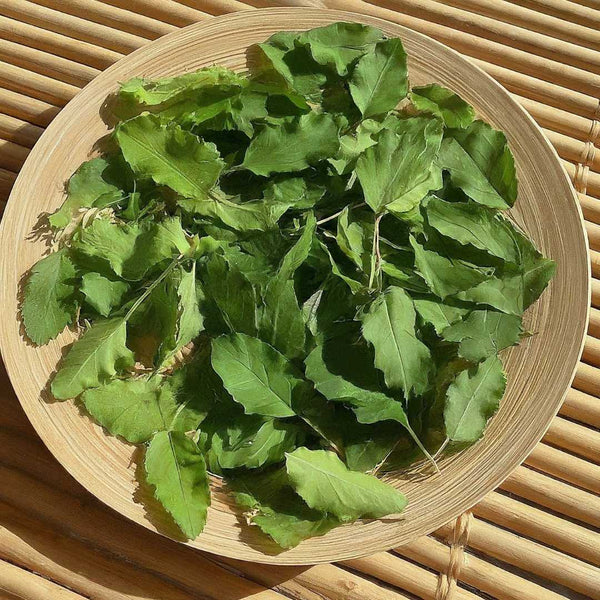
-
Natural Processes: Once harvested, the Tulsi leaves are laid out to dry. This step is crucial and is often done using traditional methods, where leaves are spread under the sun or in well-ventilated areas. The goal is to preserve the natural oils and the intrinsic aroma of the leaves, which are key to the tea's soothing properties.

-
Mindful Monitoring: The drying process is monitored closely, as the leaves must retain their green hue and essential oils. It's a delicate balance between removing moisture and preserving the leaf's natural essence. This careful drying process ensures that the leaves, once steeped, release their full spectrum of flavors and benefits.
Crafting the Tea
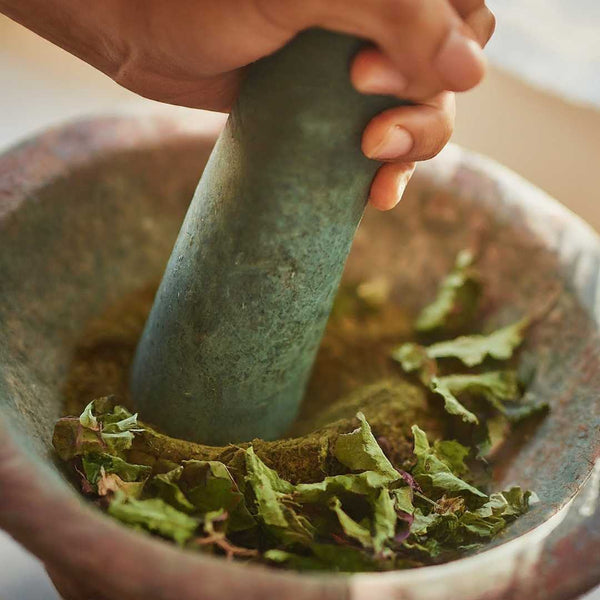
-
Gentle Grinding: After drying, the leaves are gently ground, a step that transforms the dried leaves into a form ready for brewing. This grinding is often done to a precise coarseness, allowing the leaves to unfurl and steep properly, releasing their full flavor and therapeutic properties into your cup.
-
Packing with Care: The ground Tulsi leaves are then packed, often in tea bags or kept loose, depending on the preference. This packaging is designed to protect the tea's quality, ensuring that the aroma and essence of Tulsi are preserved until it's time to brew.
The Final Journey: Brewing Your Cup
After the meticulous process of harvesting, drying, and packaging, Tulsi Tea is ready to make its final journey into your cup, transforming from a revered leaf into a soothing, aromatic beverage.
Discovering the Varieties of Tulsi
There are several types of Tulsi tea, each offering a unique flavor profile and health benefits. Here's an overview of the most common types:
-
Rama Tulsi Tea: Rama Tulsi, also known as green leaf Tulsi, is the most common variety. It has a light, crisp flavor, somewhat similar to clover. Rama Tulsi tea is known for its cooling and mellow taste, and it is believed to have stress-relieving properties, making it a great choice for relaxation.
-
Krishna Tulsi Tea: Krishna Tulsi, or purple leaf Tulsi, has a darker color and a stronger flavor compared to Rama Tulsi. Its tea is often described as having a peppery and clove-like taste. Krishna Tulsi tea is praised for its potential to support the immune system and enhance stamina.
-
Vana Tulsi Tea: Vana Tulsi, or wild leaf Tulsi, is less common and has a more citrusy and aromatic flavor. This variety grows wild in many parts of Asia and Africa. Vana Tulsi tea is sought after for its uplifting effects and is said to help with respiratory issues and boost energy levels.
-
Amrita Tulsi Tea: Amrita Tulsi is known for its medicinal properties and has a sweeter taste compared to other types. This variety is often used in Ayurvedic preparations for its health-boosting properties, including promoting longevity and vitality.
-
Blended Tulsi Tea: Many commercial Tulsi teas are blends of different Tulsi varieties, sometimes combined with other herbs and spices like ginger, lemongrass, mint, and cardamom. We have also our own blend of Tulsi Tea. Check out Tulsi Tranquility Herbal Tea for more. These blends offer a complex flavor profile and a wide range of health benefits, making them a popular choice for tea enthusiasts looking for both taste and therapeutic qualities.
Each type of Tulsi tea brings its own unique set of benefits, including stress reduction, immune system support, improved digestion, and enhanced energy and stamina. The choice of Tulsi tea can depend on personal taste preferences as well as specific health goals. Drinking Tulsi tea is a delightful way to incorporate the healing properties of this sacred plant into your daily routine.
Conclusion
Tulsi herbal tea, or Holy Basil tea, is a natural and effective way to enhance your health and well-being. With its numerous health benefits and delightful flavor, it's no wonder that Tulsi tea has been cherished for centuries. Make it a part of your daily routine and experience the benefits for yourself.
FAQs: Everything You Wanted to Know About Tulsi Tea
Q: Can I drink Tulsi Tea if I’m caffeine-sensitive?
A: Absolutely! Tulsi Tea is naturally caffeine-free, making it the perfect beverage for any time of day, especially if you’re looking to avoid the jitters that come with caffeine.
Q: How can Tulsi Tea fit into my daily routine?
A: Tulsi Tea is incredibly versatile. Start your morning with a cup for a gentle wake-up, enjoy it as a midday stress-reliever, or sip it in the evening to unwind before bed. It’s your wellness companion throughout the day.
Q: Is Tulsi (Holy Basil) tea safe to drink every day?
A: Yes, Tulsi tea is safe for daily consumption and can offer numerous health benefits.
Q: Can Tulsi (Holy Basil) tea help with weight loss?
A: Tulsi tea can aid in weight loss by boosting metabolism and promoting fat burning.
Q: Are there any side effects of Tulsi (Holy Basil) tea?
A: Tulsi tea is generally safe, but excessive consumption may cause mild side effects like nausea or diarrhea.
Q: Can pregnant women drink Tulsi (Holy Basil) tea?
A: It's best to consult a healthcare provider before consuming Tulsi tea during pregnancy.
